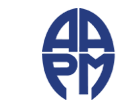| Question 1: Which of the following techniques is useful for helping to isolate the cause of an artifact in a flat field digital radiographic image?
|
| Reference: | AAPM Report 151 Ongoing Quality Control in Digital Radiography, Feb 2015, American Association of Physicists in Medicine, p. 20-21. |
| Choice A: | Rotating the image receptor relative to the x-ray tube. |
| Choice B: | Shifting the image receptor relative to the x-ray tube. |
| Choice C: | Rotating the added filter. |
| Choice D: | All of the above. |
| Question 2: The presence of a paired positive/negative density artifact in a digital radiographic image is most likely caused by which of the following?
|
| Reference: | Walz-Flannigan, A, D Magnuson, D Erickson, and B Schueler. “Artifacts in Digital Radiography.” AJR 198:156–161, 2012.
|
| Choice A: | Shift in position of debris in the beam present during gain calibration. |
| Choice B: | Backscatter from exposure of objects located behind the detector. |
| Choice C: | Residual signal from a previous exposure. |
| Choice D: | Patient motion resulting from long exposure times. |
| Question 3: Which of the following is NOT likely to be a cause of a CT artifact?
|
| Reference: | Computed Tomography: Principles, Design, Artifacts, and Recent Advances (Chapter 7), Jiang Hsieh, SPIE Press, Bellingham, WA, ISBN 0-8194-4425-1 |
| Choice A: | Miscalibrated detector. |
| Choice B: | Contrast agent on the gantry window. |
| Choice C: | Inappropriate window/level setting. |
| Choice D: | Low mAs setting. |
| Choice E: | Dental filling. |
| Question 4: Which one of the following statements is TRUE:
|
| Reference: | Conti M. Why is TOF PET reconstruction a more robust method in the presence of inconsistent data? Phys Med Biol 2011;56:155-168. |
| Choice A: | Time-of-flight PET mitigates respiratory motion artifacts. |
| Choice B: | Attenuation correction artifacts in PET/MR are not as prevalent as in PET/CT. |
| Choice C: | A rigorous daily QA regimen will prevent scanner failures throughout the day. |
| Choice D: | The failure of a PET detector creates focal areas of decreased uptake in a reconstructed PET image. |
| Question 5: Regarding “zipper” artifacts caused by radiofrequency interference, the appearance of the “zipper” or line extends in which direction:
|
| Reference: | DW McRobbie, EA Moore, MJ Graves, MR Prince, “MRI: From Picture to Proton,” 2nd edition, Cambridge University Press, pg. 103 |
| Choice A: | Anterior – posterior. |
| Choice B: | Frequency encoding. |
| Choice C: | Phase encoding. |
| Choice D: | X-Y. |
| Question 6: A pattern of regularly spaced lines extending across an MR image is most likely caused by:
|
| Reference: | DW McRobbie, EA Moore, MJ Graves, MR Prince, “MRI: From Picture to Proton,” 2nd edition, Cambridge University Press, pg. 104
|
| Choice A: | Metal. |
| Choice B: | Pulsatile flow. |
| Choice C: | Chemical shift. |
| Choice D: | Spikes in k-space. |
